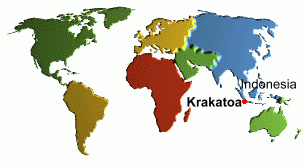 Krakatoa (or Krakatau, its Indonesian name) is a volcano in what is now called Indonesia, located between Sumatra and Java. It erupted repeatedly, massively and with disastrous consequences on August 26, 1883. Its explosive eruptions were so loud that they could be heard in Australia, over 3500 km away. Krakatoa was the most violent eruption ever in modern times; its explosive power has been calculated at over 200 megatons of TNT ... or 10,000 times the energy of the bomb that fell on Hiroshima! Sound waves from the explosions travelled seven times around the world. The sky was darkened for days afterwards. Almost all of the island on which Krakatoa sat was obliterated.
Krakatoa (or Krakatau, its Indonesian name) is a volcano in what is now called Indonesia, located between Sumatra and Java. It erupted repeatedly, massively and with disastrous consequences on August 26, 1883. Its explosive eruptions were so loud that they could be heard in Australia, over 3500 km away. Krakatoa was the most violent eruption ever in modern times; its explosive power has been calculated at over 200 megatons of TNT ... or 10,000 times the energy of the bomb that fell on Hiroshima! Sound waves from the explosions travelled seven times around the world. The sky was darkened for days afterwards. Almost all of the island on which Krakatoa sat was obliterated.
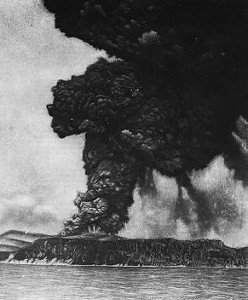
As Krakatoa was erupting, ash fell on Singapore (840 km north), and Keeling Island (1155 km southwest), and on ships as far away as 6000 km. Total darkness covered the region near the island itself for three full days. The eruption may have had a plume of dust, rock and smoke 80 km high. It probably ejected over 20 cubic kilometers of material. Eruptions of this size occur only once every few hundred years on Earth. Blast waves from the explosions cracked walls and broke windows up to 160 km away. Ships navigating the seas near Krakatoa reported that floating pumice had formed a layer about 3 meters thick on top of the water. Other ships as far away as 250 km reported that their decks were covered with volcanic dust three days after the end of the eruption. On nearby islands everything was buried under a thick layer of ash. Plant and animal life were wiped out. People who heard the explosions on Rodriguez Island, over 4600 km away, described them as sounding like the distant roar of firing cannons. 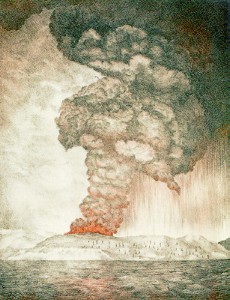 Dust and ash from the eruption circled the Earth in two weeks, forming a cloud which completely covered
the upper atmosphere at the latitude of Indonesia. Three months after the eruption this belt of volcanic dust had spread to higher latitudes, causing spectacular red, blue and green sunsets in America and Europe for the next three years. Dust and ash from the eruption circled the Earth in two weeks, forming a cloud which completely covered
the upper atmosphere at the latitude of Indonesia. Three months after the eruption this belt of volcanic dust had spread to higher latitudes, causing spectacular red, blue and green sunsets in America and Europe for the next three years.This dust in the atmosphere not only created these spectacular atmospheric effects, but also acted as a filter, reducing the amount of sunlight reaching the surface of the Earth. In the year following the eruption, average global temperatures dropped as much as 1.2°C. Weather patterns around the world continued to be affected for years after the eruption. Krakatoa's explosion was 'phreatomagmatic' . Ocean water entered the magma chambers of the volcano; super-heated steam built tremendous pressure, which caused the incredibly large explosion. 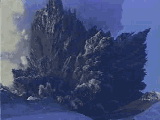 During the eruptions, tremors created giant waves in the surrounding ocean, which reached heights of 40 m above sea level, devastating everything in their path and hurling ashore coral blocks weighing as much as 500 tonnes.
'Rafts' of floating pumice 3 metres thick covered the ocean around the volcano before it started to disperse; some of this material crossed the Indian Ocean; much of it was still afloat two years after the eruption.
During the eruptions, tremors created giant waves in the surrounding ocean, which reached heights of 40 m above sea level, devastating everything in their path and hurling ashore coral blocks weighing as much as 500 tonnes.
'Rafts' of floating pumice 3 metres thick covered the ocean around the volcano before it started to disperse; some of this material crossed the Indian Ocean; much of it was still afloat two years after the eruption.
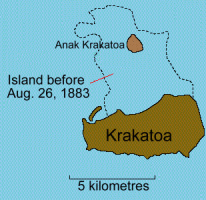 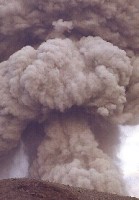 When the eruption ended, two thirds of the island on which Krakatoa sat had been obliterated. But it was the ocean that was responsible for the most deaths; at least 36,417 people were killed, most by the tsunami waves generated by the explosion; 165 coastal villages were destroyed..
When the eruption ended, two thirds of the island on which Krakatoa sat had been obliterated. But it was the ocean that was responsible for the most deaths; at least 36,417 people were killed, most by the tsunami waves generated by the explosion; 165 coastal villages were destroyed..Whole settlements of indigenous peoples were wiped out. Bodies of victims could be found floating in the ocean for weeks after the event. An additional 1000 or so people also died from volcanic fumes and ashes. 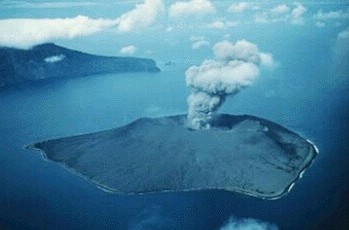 Since 1927, small eruptions have constructed a new island (see diagram above), called Anak Krakatau ('Child of Krakatau'). This new volcano has been the subject of study by scientists since 1960. Since 1927, small eruptions have constructed a new island (see diagram above), called Anak Krakatau ('Child of Krakatau'). This new volcano has been the subject of study by scientists since 1960.In January of that year a group of scientists visited Anak Krakatau to record its renewed activity and to measure changes in the size and shape of the island. They observed explosive eruptions of pyroclasts from ash to boulders in size. The photograph at the right shows a column of ash rising above the island. Rakata, a remnant of the volcano prior to the 1883 eruption, is in the background The 1883 eruption of Krakatoa was not the largest known in recorded history. The explosion of the volcano of Santorin (Thera) which occurred in the Aegean Sea in in the fifteenth century BC was at least six and one half times greater in energy release than that of Krakatoa. Also, the volcanic explosion of Mount Vesuvius in 79 A.D, the one that buried Pompeii, was greater than that of Krakatoa. 'Krakatoa: The Day the Earth Exploded' by Simon Winchester, Harper Collins Publishing] |